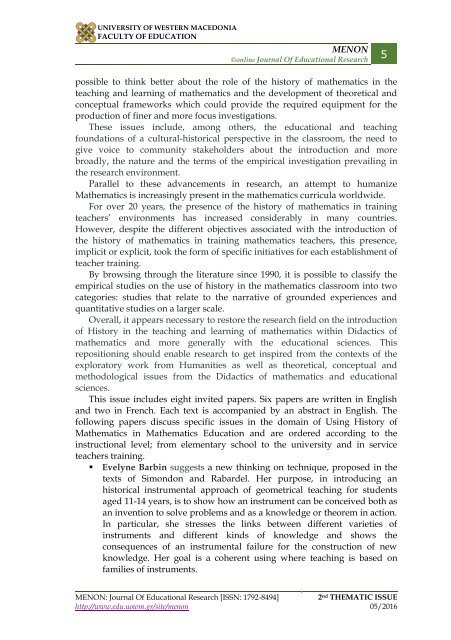MENON
menon_issue_2nd_special_052016
menon_issue_2nd_special_052016
Create successful ePaper yourself
Turn your PDF publications into a flip-book with our unique Google optimized e-Paper software.
UNIVERSITY OF WESTERN MACEDONIA<br />
FACULTY OF EDUCATION<br />
<strong>MENON</strong><br />
©online Journal Of Educational Research<br />
5<br />
possible to think better about the role of the history of mathematics in the<br />
teaching and learning of mathematics and the development of theoretical and<br />
conceptual frameworks which could provide the required equipment for the<br />
production of finer and more focus investigations.<br />
These issues include, among others, the educational and teaching<br />
foundations of a cultural-historical perspective in the classroom, the need to<br />
give voice to community stakeholders about the introduction and more<br />
broadly, the nature and the terms of the empirical investigation prevailing in<br />
the research environment.<br />
Parallel to these advancements in research, an attempt to humanize<br />
Mathematics is increasingly present in the mathematics curricula worldwide.<br />
For over 20 years, the presence of the history of mathematics in training<br />
teachers’ environments has increased considerably in many countries.<br />
However, despite the different objectives associated with the introduction of<br />
the history of mathematics in training mathematics teachers, this presence,<br />
implicit or explicit, took the form of specific initiatives for each establishment of<br />
teacher training.<br />
By browsing through the literature since 1990, it is possible to classify the<br />
empirical studies on the use of history in the mathematics classroom into two<br />
categories: studies that relate to the narrative of grounded experiences and<br />
quantitative studies on a larger scale.<br />
Overall, it appears necessary to restore the research field on the introduction<br />
of History in the teaching and learning of mathematics within Didactics of<br />
mathematics and more generally with the educational sciences. This<br />
repositioning should enable research to get inspired from the contexts of the<br />
exploratory work from Humanities as well as theoretical, conceptual and<br />
methodological issues from the Didactics of mathematics and educational<br />
sciences.<br />
This issue includes eight invited papers. Six papers are written in English<br />
and two in French. Each text is accompanied by an abstract in English. The<br />
following papers discuss specific issues in the domain of Using History of<br />
Mathematics in Mathematics Education and are ordered according to the<br />
instructional level; from elementary school to the university and in service<br />
teachers training.<br />
• Evelyne Barbin suggests a new thinking on technique, proposed in the<br />
texts of Simondon and Rabardel. Her purpose, in introducing an<br />
historical instrumental approach of geometrical teaching for students<br />
aged 11-14 years, is to show how an instrument can be conceived both as<br />
an invention to solve problems and as a knowledge or theorem in action.<br />
In particular, she stresses the links between different varieties of<br />
instruments and different kinds of knowledge and shows the<br />
consequences of an instrumental failure for the construction of new<br />
knowledge. Her goal is a coherent using where teaching is based on<br />
families of instruments.<br />
<strong>MENON</strong>: Journal Of Educational Research [ISSN: 1792-8494]<br />
http://www.edu.uowm.gr/site/menon<br />
2 nd THEMATIC ISSUE<br />
05/2016


